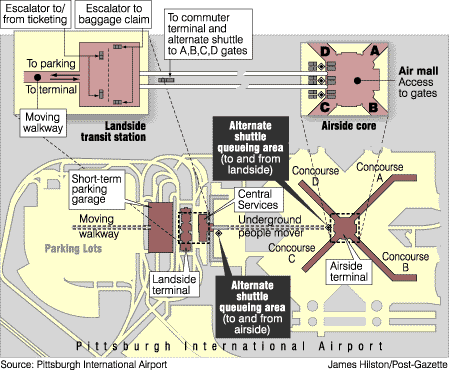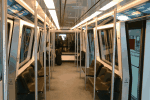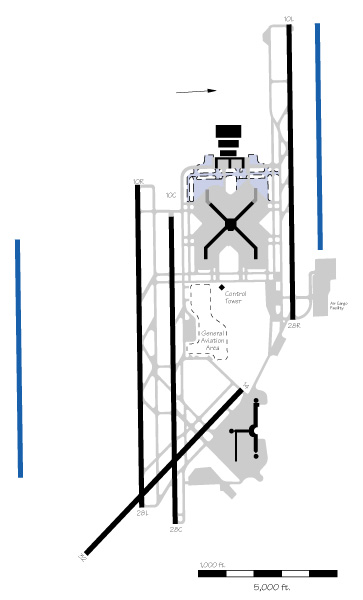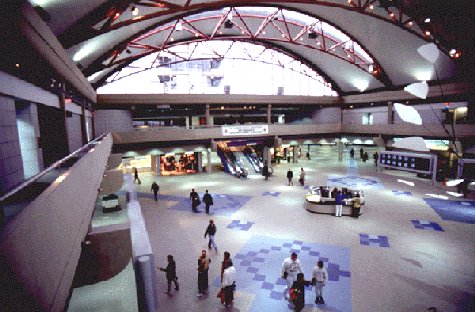| Home > All By Location regional map > Clinton > Airport People Mover Tunnel | |||
|
|
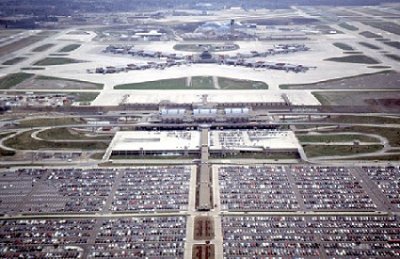
Aerial view east: Covered moving walkway, in foreground, connects parking lot and garage to Landside building. People mover tunnel links Landside building to X-shaped Airside building in distance. (County Dept of Aviation) OFFICIAL NAME: Pittsburgh International Airport People Mover OTHER DESIGNATION: Airport People Mover Tunnel Automated Guideway Transit System LOCATION: Findlay Twp USGS 7.5" Topo Quad - UTM Coordinates: Clinton - Zone 17; 0563 4482 CARRIES: People Mover train BETWEEN: -- Landside Terminal -- Airside Terminal UNDER: Pittsburgh International Airport taxiways TYPE OF CONSTRUCTION / DESIGN: two parallel tunnels TOTAL LENGTH: 2,600 ft est OTHER DIMENSIONS: YEAR OPENED / ENGINEER: 1992, Adtranz Michael Baker Corporation, airport project engineers Tasso Katselas, terminal architect Department of Aviation, County of Allegheny ADDITIONAL INFO: The Pittsburgh International Airport opened in October 1992. It occupies 12,900 acres in Findlay and Moon Townships, approximately 16 miles west of Pittsburgh. It replaced the 1952 terminal building which stood in Moon Twp at the northeast corner of the property until demolition in 1997. from the Pittsburgh International Airport website: The grand strategy of the terminal is a series of three specialized buildings linked by high speed, automated walkways, escalators and people movers with the airplanes at one end and the parking lot at the other. The highway arrival network is designed to avoid anxiety that comes with congestion and confusion. Passengers drive to the landside building, drop off their luggage and proceed to the parking areas. Cabs, buses and other pubic carriers do not compete with automobiles for curb space. Cars go to the west curb of landside, busses and taxis to the east curb. There is even a separate entrance and exit for rental cars. The parking lot and parking garage, combined, provide more than 17,000 spaces. There are enclosed, climate-controlled moving walkways and vans to carry passengers using the parking facility to and from their autos. The landside building and the core of the airside building have three levels, plus one mezzanine. The interior of the landside building is about the size of two football fields. It is covered by a series of barrel-vault roofs 60 feet above the floor. Natural light from enormous arched windows and skylights fill the space. After ticketing, the traveler takes an escalator to the security checkpoint, then boards a people mover to the airside building. Commuter passengers take an escalator up to the commuter building. In the past, commuter passengers have often been treated as second-class travelers. But Pittsburgh International is a hub airport and serves many feeder airlines. Now commuters have their own terminal. When they arrive, their baggage is transferred automatically to their connecting flight and they have direct access to the airside building. The three buildings are linked by two parallel tunnels carrying two-car people movers with a capacity for 80 passengers in each car. The trip between the landside and airside terminals takes just 70 seconds, including boarding time. The airside building consists of a large atrium with four concourse arms, usually described as a giant X. Two arms, with a total of 50 gates, are used by USAir. A third arm is earmarked for other domestic airlines, and the fourth is for international airlines. Moving sidewalks move a deplaning passenger from plane to parking in 11 minutes. Conveyor belts with laser scanners send the passengers' bar-coded luggage zipping through one of seven tunnels to the proper airplane or carousel. - - - The Airport people mover was designed by Adtranz North America of West Mifflin, PA. Westinghouse Electric Corportion, a predecessor of this company, developed Skybus in the late 1960s as one of the first people mover systems. It, too, featured rubber-tired vehicles linked to a guideway and moving automatically between stations without an on-board operator. Skybus was proposed as a mass transit link between downtown Pittsburgh and the suburbs of the South Hills. Political opposition and since debunked arguments killed the Skybus plans; the "T" light rail system which opened in 1985 was also designed and built by Adtranz. The Airport people mover was placed in service in 1992 at a cost of $14 million. It logged over 600,000 miles before the system was updated and expanded in 1999. The system uses two parallel tunnels running below the taxiways and linking the Landside building and the Airside building -- a distance of about one-half mile. The rubber-tired trains complete a one-way trip between the two stations in 100 seconds: 70 seconds of travel along the automated guideway and a 30 second stop to load and unload. With its efficiently designed stations, each people mover can handle about 6,000 riders per hour. When the vehicle stops at the station, doors first open on the outer sides to allow passengers to exit. Those doors close and doors on the inner side (between the two tunnels) open to allow passengers to enter. A round window at the each end of the tunnels give visitors of the entire journey. The system was designed to allow for expansion. In 1999, the people movers were closed one tunnel at a time. Temporary walls were demolished to extend the passenger loading area. Two-car trains were replaced with three-car trains. Two new cars were added ($5.3 million) and the original four cars were updated ($1.6 million). A ground-level hatch provides access for cranes to lift the cars from the tunnels. The layout of the terminal building allows for the addition of another Airside terminal building and the people mover tunnels would be extended to reach the future building. FIELD CHECKED: INFO SOURCES: Pittsburgh International Airport website; Pittsburgh Post-Gazette; Adtranz (Bombardier Transportation) Submit info or inquiry - share some facts or ask a question. Introduction -- Nearby Structures Page created: Last modified: 26-Nov-2001 |
View Larger Map 
| |
| copyright: © Bruce S. Cridlebaugh 1999-2008 All Rights Reserved | |||
